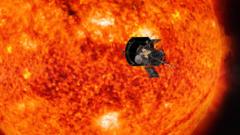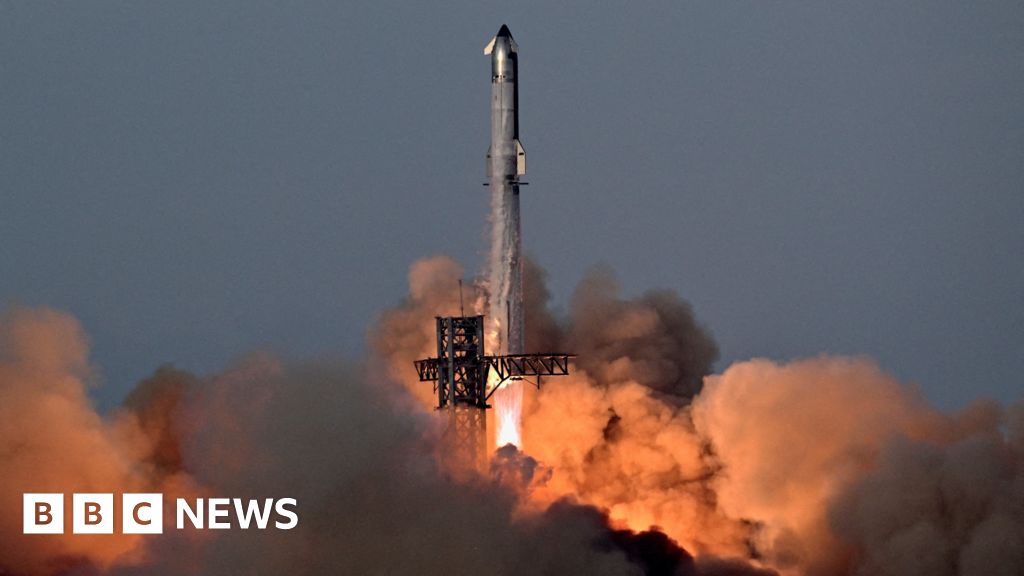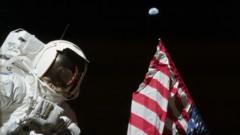The NASA spacecraft Parker Solar Probe is making headlines as it attempts the closest-ever pass by the Sun, pushing the boundaries of space exploration. Launching in 2018, this remarkable mission sees the probe dive into the Sun's outer atmosphere, the corona, where it will encounter soaring temperatures and intense radiation levels. During this fly-by, which takes place on Christmas Eve, communications with the spacecraft will be temporarily halted. Scientists are anxiously awaiting a signal on December 27, which will determine if the probe has successfully navigated these extreme conditions.
Dr. Nicola Fox, head of science at NASA, emphasized the significance of this mission, noting, "For centuries, people have studied the Sun, but you don’t experience the atmosphere of a place until you actually go visit it." Indeed, this mission marks a pivotal moment in solar research—not just for its record-breaking proximity of 3.8 million miles (6.2 million km) from the Sun's surface, but also for its potential to unlock critical insights about solar behavior.
The Parker Solar Probe has completed 21 orbits around the Sun, gradually inching closer to our star. To put its proximity into perspective, Fox explains that if the distance between the Earth and the Sun were scaled to one meter, the Parker Solar Probe would be just four centimeters away from the Sun—an astonishingly close approach. At its closest point, the probe will need to withstand temperatures exceeding 1,400 degrees Celsius and radiation levels strong enough to damage its onboard instruments. To protect itself, the probe is equipped with an 11.5 cm thick carbon-composite shield, allowing it to zip in and out of the corona at unmatched speeds of 430,000 mph—imagine flying from London to New York in under 30 seconds.
The mission aims to demystify several solar phenomena, particularly the puzzling behavior of the corona. Dr. Jenifer Millard, an astronomer at Fifth Star Labs, explains that, while the Sun's surface temperature is around 6,000 degrees Celsius, the corona reaches millions of degrees, raising questions about the heating mechanisms involved. Previous observations during solar eclipses have shown this phenomenon, but in-depth study remains elusive.
Additionally, the Parker Solar Probe endeavors to enhance our understanding of the solar wind—streams of charged particles ejected from the corona. These interactions can lead to mesmerizing auroras on Earth, but they may also disrupt power grids and communication networks. Dr. Millard highlights the mission's relevance: "Understanding the Sun, its activity, space weather, the solar wind, is so important to our everyday lives on Earth."
As the team awaits data from the spacecraft during its communication blackout, Fox expresses her confidence in its design and durability, reassuring that the probe is built to withstand harsh conditions. Once communication resumes, she eagerly anticipates a signal indicating the probe's successful mission completion, signified by a highly anticipated green heart emoji from her team, embodying the blend of science, exploration, and the human spirit that characterizes NASA’s ambitious foray into the heart of our Solar System.
Dr. Nicola Fox, head of science at NASA, emphasized the significance of this mission, noting, "For centuries, people have studied the Sun, but you don’t experience the atmosphere of a place until you actually go visit it." Indeed, this mission marks a pivotal moment in solar research—not just for its record-breaking proximity of 3.8 million miles (6.2 million km) from the Sun's surface, but also for its potential to unlock critical insights about solar behavior.
The Parker Solar Probe has completed 21 orbits around the Sun, gradually inching closer to our star. To put its proximity into perspective, Fox explains that if the distance between the Earth and the Sun were scaled to one meter, the Parker Solar Probe would be just four centimeters away from the Sun—an astonishingly close approach. At its closest point, the probe will need to withstand temperatures exceeding 1,400 degrees Celsius and radiation levels strong enough to damage its onboard instruments. To protect itself, the probe is equipped with an 11.5 cm thick carbon-composite shield, allowing it to zip in and out of the corona at unmatched speeds of 430,000 mph—imagine flying from London to New York in under 30 seconds.
The mission aims to demystify several solar phenomena, particularly the puzzling behavior of the corona. Dr. Jenifer Millard, an astronomer at Fifth Star Labs, explains that, while the Sun's surface temperature is around 6,000 degrees Celsius, the corona reaches millions of degrees, raising questions about the heating mechanisms involved. Previous observations during solar eclipses have shown this phenomenon, but in-depth study remains elusive.
Additionally, the Parker Solar Probe endeavors to enhance our understanding of the solar wind—streams of charged particles ejected from the corona. These interactions can lead to mesmerizing auroras on Earth, but they may also disrupt power grids and communication networks. Dr. Millard highlights the mission's relevance: "Understanding the Sun, its activity, space weather, the solar wind, is so important to our everyday lives on Earth."
As the team awaits data from the spacecraft during its communication blackout, Fox expresses her confidence in its design and durability, reassuring that the probe is built to withstand harsh conditions. Once communication resumes, she eagerly anticipates a signal indicating the probe's successful mission completion, signified by a highly anticipated green heart emoji from her team, embodying the blend of science, exploration, and the human spirit that characterizes NASA’s ambitious foray into the heart of our Solar System.




















